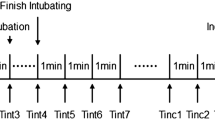Abstract
Background
Postanesthetic shivering can be triggered by surgical stress and several aspects of anesthetic management and is frequently preceded by a decrease in peripheral blood flow due to thermoregulatory vasoconstriction. As perfusion index correlates with peripheral blood flow, we examined whether perioperative perfusion index, measured using pulse oximetry, might be correlated with postanesthetic shivering.
Methods
Twenty-eight patients presenting for elective abdominal surgery were enrolled. Core (esophagus) and peripheral (finger) temperatures and perfusion index were recorded in the perioperative periods. Correlations between perfusion index and peripheral temperature and core-to-peripheral temperature gradient were then explored. Plasma levels of epinephrine and norepinephrine were also measured. The extent of shivering was graded after emergence from anesthesia.
Results
Perfusion index declined before emergence from anesthesia in patients who then developed postanesthetic shivering. This coincided with the time at which the difference between core and peripheral temperature became dissociated and peripheral temperature declined. Perioperative perfusion index was correlated with peripheral temperature and peripheral-core temperature gradient. Perfusion index at closure of the peritoneum predicted postanesthetic shivering and was significantly correlated with the extent of shivering. Plasma levels of both epinephrine and norepinephrine were significantly elevated after shivering events.
Conclusions
Perfusion index was significantly lower in patients with postanesthetic shivering before emergence from anesthesia, indicating that measurement of perfusion index during and before the end of anesthesia might be a useful means of predicting postanesthetic shivering.




Similar content being viewed by others
References
Sessler DI. Mild perioperative hypothermia. N Engl J Med. 1997;336(24):1730–7.
Sessler DI. Temperature monitoring and perioperative thermoregulation. Anesthesiology. 2008;109(2):318–38.
Buggy DJ, Crossley AW. Thermoregulation, mild perioperative hypothermia and postanaesthetic shivering. Br J Anaesth. 2000;84(5):615–28.
Sessler DI, Rubinstein EH, Moayeri A. Physiologic responses to mild perianesthetic hypothermia in humans. Anesthesiology. 1991;75(4):594–610.
Lima A, Bakker J. Noninvasive monitoring of peripheral perfusion. Intensive Care Med. 2005;31(10):1316–26.
Lima AP, Beelen P, Bakker J. Use of a peripheral perfusion index derived from the pulse oximetry signal as a noninvasive indicator of perfusion. Crit Care Med. 2002;30(6):1210–3.
De Felice C, Latini G, Vacca P, Kopotic RJ. The pulse oximeter perfusion index as a predictor for high illness severity in neonates. Eur J Pediatr. 2002;161(10):561–2.
Zaramella P, Freato F, Quaresima V, Ferrari M, Vianello A, Giongo D, Conte L, Chiandetti L. Foot pulse oximeter perfusion index correlates with calf muscle perfusion measured by near-infrared spectroscopy in healthy neonates. J Perinatol. 2005;25(6):417–22.
Mowafi HA, Ismail SA, Shafi MA, Al-Ghamdi AA. The efficacy of perfusion index as an indicator for intravascular injection of epinephrine-containing epidural test dose in propofol-anesthetized adults. Anesth Analg. 2009;108(2):549–53.
Johnson JM, Kellogg DL Jr. Local thermal control of the human cutaneous circulation. J Appl Physiol. 2010;109(4):1229–38.
House JR, Tipton MJ. Using skin temperature gradients or skin heat flux measurements to determine thresholds of vasoconstriction and vasodilatation. Eur J Appl Physiol. 2002;88(1–2):141–5.
Sessler DI, McGuire J, Hynson J, Moayeri A, Heier T. Thermoregulatory vasoconstriction during isoflurane anesthesia minimally decreases cutaneous heat loss. Anesthesiology. 1992;76(5):670–5.
Lenhardt R, Greif R, Sessler DI, Laciny S, Rajek A, Bastanmehr H. Relative contribution of skin and core temperatures to vasoconstriction and shivering thresholds during isoflurane anesthesia. Anesthesiology. 1999;91(2):422–9.
Cheng C, Matsukawa T, Sessler DI, Ozaki M, Kurz A, Merrifield B, Merrifield B, Olofsson P. Increasing mean skin temperature linearly reduces the core-temperature thresholds for vasoconstriction and shivering in humans. Anesthesiology. 1995;82(5):1160–8.
Nakasuji M, Nakamura M, Imanaka N, Tanaka M, Nomura M, Suh SH. Intraoperative high-dose remifentanil increases post-anaesthetic shivering. Br J Anaesth. 2010;105(2):162–7.
Crossley AW, Mahajan RP. The intensity of postoperative shivering is unrelated to axillary temperature. Anaesthesia. 1994;49(3):205–7.
Kose EA, Dal D, Akinci SB, Saricaoglu F, Aypar U. The efficacy of ketamine for the treatment of postoperative shivering. Anesth Analg. 2008;106(1):120–2 (table of contents).
Cannesson M, Desebbe O, Rosamel P, Delannoy B, Robin J, Bastien O, Lehot JJ. Pleth variability index to monitor the respiratory variations in the pulse oximeter plethysmographic waveform amplitude and predict fluid responsiveness in the operating theatre. Br J Anaesth. 2008;101(2):200–6.
Forget P, Lois F, de Kock M. Goal-directed fluid management based on the pulse oximeter-derived pleth variability index reduces lactate levels and improves fluid management. Anesth Analg. 2010;111(4):910–4.
Lenhardt R, Negishi C, Sessler DI, Ozaki M, Ettinger K, Bastanmehr H, Lobo E. The effect of pyrogen administration on sweating and vasoconstriction thresholds during desflurane anesthesia. Anesthesiology. 1999;90(6):1587–95.
Maguire S, Rinehart J, Vakharia S, Cannesson M. Technical communication: respiratory variation in pulse pressure and plethysmographic waveforms: intraoperative applicability in a North American academic center. Anesth Analg. 2011;112(1):94–6.
Eberhart LH, Doderlein F, Eisenhardt G, Kranke P, Sessler DI, Torossian A, Wulf H, Morin AM. Independent risk factors for postoperative shivering. Anesth Analg. 2005;101(6):1849–57.
Horn EP, Schroeder F, Wilhelm S, Sessler DI, Standl T, von dem Busche K, Schulte am Esch J. Postoperative pain facilitates nonthermoregulatory tremor. Anesthesiology. 1999;91(4):979–84.
Frank SM, Higgins MS, Breslow MJ, Fleisher LA, Gorman RB, Sitzmann JV, Raff H, Beattie C. The catecholamine, cortisol, and hemodynamic responses to mild perioperative hypothermia. A randomized clinical trial. Anesthesiology. 1995;82(1):83–93.
Gehring H, Hornberger C, Matz H, Konecny E, Schmucker P. The effects of motion artifact and low perfusion on the performance of a new generation of pulse oximeters in volunteers undergoing hypoxemia. Respir Care. 2002;47(1):48–60.
Author information
Authors and Affiliations
Corresponding author
Additional information
C. Kuroki and K. Godai contributed equally to this work.
About this article
Cite this article
Kuroki, C., Godai, K., Hasegawa-Moriyama, M. et al. Perfusion index as a possible predictor for postanesthetic shivering. J Anesth 28, 19–25 (2014). https://doi.org/10.1007/s00540-013-1658-9
Received:
Accepted:
Published:
Issue Date:
DOI: https://doi.org/10.1007/s00540-013-1658-9




